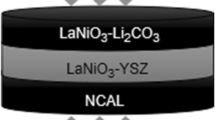Abstract
LaGaO3-based perovskite oxide doped with Sr and Mg exhibits high ionic conduction over a wide oxygen partial pressure. In this study, the stability of the LaGaO3 based oxide was investigated. It became clear that LaGaO3 based oxide is very stable for reduction and oxidation. SOFCs utilizing LaGaO3-based perovskite type oxide for electrolyte were further studied for the decreased temperature solid oxide fuel cells. The power generation characteristics of cells were strongly affected by the electrode, both anode and cathode. It became clear that Ni and LnCoO3 (Ln: rare earth) are suitable for anode and cathode, respectively. Rare earth cations in the Ln-site of Co-based perovskite cathode also have a great effect on the power generation characteristics. In particular, high power density could be attained in the temperature range from 973 to 1273 K by using doped SmCoO3 for the cathode. The electrical conductivity of SmCoO3 increases with increasing Sr amount doped for the Sm site and attained the maximum at Sm0.5Sr0.5CoO3. The cathodic overpotential and the internal cell resistance exhibit almost opposite dependence on the amount of doped Sr. Consequently, the power density of the cell reaches a maximum when Sm0.5Sr0.5CoO3 is used for cathode. On this cell, the maximum power density is as high as 0.58 W/cm2 at 1073 K, although a 0.5 mm thick electrolyte is used. Therefore, this study reveals that the LaGaO3 based oxide for electrolyte and the SmCoO3 based oxide for cathode are promising for solid oxide fuel cells at intermediate temperature.
Similar content being viewed by others
5. References
B.C.H. Steele, J. Power Source49, 1 (1994).
H.L. Tuller and A.W. Nowick, J. Electrochem. Soc.122, 255 (1975).
M. Godickemeier, K. Sasaki, L.I. Gauckler, and I. Riess, J. Electrochem. Soc.144, 1635 (1997).
I. Yasuda and M. Hishinuma, Abstract of the 1997 Joint International Meeting (Paris), Vol. 97–2, No. 2141 (1997).
A. Atkinson, Solid State Ionics95, 249 (1997).
S. de Souza, S.J. Visco, and L.C. de Jonghe, J. Electrochem. Soc.144, L35 (1997).
T. Ishihara, H. Matsuda, and Y. Takita, J. Am. Chem. Soc.116, 3801 (1994).
T. Ishihara, H. Matsuda, and Y. Takita, Solid State Ionics79, 147 (1995).
M. Feng and J.B. Goodenough, Eur. J. Solid State Inorg. Chem.31, 663 (1994).
P.N. Huang and A. Petric, J. Electrochem. Soc.143, 1644 (1996).
J.W. Stevenson, T.R. Armstrong, D.E. McCready, L.R. Pederson, and W.J. Weber, J. Electrochem. Soc.144, 3613 (1997).
R.T. Baker, B. Gharbage, and F.M.B. Marques, J. Electrochem. Soc.144, 3130 (1997).
T. Ishihara, H. Minami, H. Matsuda, H. Nishiguchi, and Y. Takita, J.C.S. Chem. Comm. 929 (1996).
T. Ishihara, T. Kudo, H. Matsuda, and Y. Takita, J. Am. Ceram. Soc.77, 1682 (1994).
W. Marti, P. Fischer, F. Altorfer, H.J. Scheel and M. Tadin, J. Phys. Condens. Matter6, 127 (1994).
P.R. Slater, J.T.S. Irvine, T. Ishihara, and Y. Takita, Solid State Ionics, in press.
K.S. Mazzdiyasni, C.T. Lynch, and J.S. Smith, J. Am. Ceram. Soc.50, 532 (1967).
F.K. Moghadam and D.A. Stevenson, J. Am. Ceram. Soc.65, 213 (1982).
J. Drennan, V. Zelizko, D. Hay, F.T. Ciacchi, S. Rajendran, and S. P.S. Badwal, J. Mater. Chem.7, 79 (1997).
T. Ishihara, M. Honda, J.A. Kilner, Y. Takita, J. Am. Chem. Soc.119, 2747 (1997).
K. Yamaji, T. Horita, M. Ishikawa, N. Sakai, H. Yokokawa, and M. Dokiya, in: Solid Oxide Fuel Cells (V.U. Stimming, S.C. Singhal, T. Tagawa, and W. Lehnert, Ed.) PV97–40, The Electrochemical Socierty Proceedings Series, Pennington, NJ (1997) p. 1041.
T. Ishihara, T. Kudo, H. Matsuda, and Y. Takita, J. Electrochem. Soc.142, 1519 (1995).
T. Ishihara, H. Minami, H. Matsuda, H. Nishiguchi, and Y. Takita, Denki Kagaku64, 642 (1996).
J.A. Kilner, in: Proc. 2nd Inter. Symp. Ionic and Mixed Conducting Ceramics (T.A.Ramanarayanan, W.L. Worell, and T.L. Tuller, Ed.) PV 94–12, The Electrochemical Socierty Proceedings Series, Pennington, NJ (1994) p.174.
H.Y. Tu, Y. Takeda, N. Imanishi, and O. Yamamoto, Solid State Ionics100, 283 (1997).
Author information
Authors and Affiliations
Rights and permissions
About this article
Cite this article
Ishihara, T., Honda, M., Shibayama, T. et al. An intermediate temperature solid oxide fuel cell utilizing superior oxide ion conducting electrolyte, doubly doped LaGaO3 perovskite. Ionics 4, 395–402 (1998). https://doi.org/10.1007/BF02375883
Received:
Accepted:
Issue Date:
DOI: https://doi.org/10.1007/BF02375883




